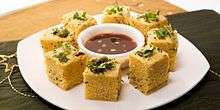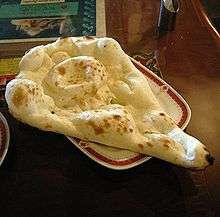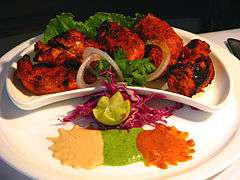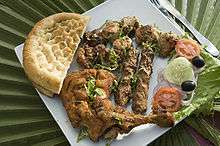Dal
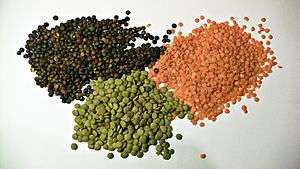 Lentils are a staple ingredient in South Asian cuisine. Clockwise from upper right: split red lentils, common green whole lentils, and Le Puy lentils both with their outer coats visible | |
| Main ingredients | Lentils, peas or beans |
|---|---|
|
| |
Dal (also spelled daal or dhal) (IPA: [d̪aːl]) is a South Asian term for dried, split pulses (that is, lentils, peas, and beans). The term is also used for various soups prepared from these pulses. These pulses are among the most important staple foods in South Asia, and form an important part of Indian, Nepali, Pakistani, Sri Lankan and Bangladeshi cuisine.[1]
Dals are frequently eaten with flatbreads such as rotis or chapatis or with rice, a combination referred to as dal bhat. Dals are high in protein.
The outer hull is usually stripped off; dal that has not been hulled is described as chilka (skin), e.g. chilka urad dal, mung dal chilka.[2][3] The term dal is often contrasted with the term gram, used in South Asia for pulses that are whole rather than split.[1]
Etymology
The word dāl derives from the Sanskrit verbal root dal- "to split".[4]
Use by region
Dal preparations are eaten with rice, as well as roti, chapati and naan on the Indian subcontinent. In India, it is eaten with rice and with a wheat flatbread called roti. The manner in which it is cooked and presented varies by region. In South India, dal is primarily used to make the dish called sambar. It is also used to make pappu that is mixed with charu and rice.
In Iran and some other middle east countries, it is usually served as a stew, called Gheimeh, with beef/lamb meat, tomato sauce, black lime and a choice of fried potato or eggplant. It is also used in a large meat ball, called koofteh, including ground beef, rice and some herbs.
Nutrition
Proteins

Its protein contents are 3.5 times that of rice and 2.5 times that of wheat. It provides an excellent source of protein, particularly for those adopting vegetarian diets or diets which do not contain much meat. It is typically around 25% protein by dry weight, giving it a comparable protein content to meats. However, by weight, cooked (boiled) dal contains 9% protein, 70% water, 20% carbohydrates (includes 8% fiber), 1% fat.[5] Note that as extra water is added to cooked dal, as in the case of sambar, proportion of proteins and other nutrients will reduce further. Protein contents of cooked dal[6] are one third that of cooked chicken.[7] Most dals (except soybean, being exceptionally higher) have a similar amount of protein.
On its own, soybean is the only vegetarian complete protein. All other dals including toor dal do not have individual amino acids within protein in ideal proportion (unlike eggs and meats). However, if the proteins in dal are combined with rice or wheat (for example, chapatis), it provides amino acids in the right proportions, making it a complete protein. Bioavailability of proteins from dals is less than those from eggs and meats.
| Food | Carbs (non-Fiber) | Fiber | Protein | Fat |
|---|---|---|---|---|
| Wheat | 100 | 20.6 | 21.3 | 2.5 |
| Rice | 100 | 1.6 | 9 | 0.8 |
| Soybean | 100 | 44.2 | 174 | 95 |
| Pigeon Pea | 100 | 31 | 45.4 | 3 |
| Milk | 100 | 0 | 61 | 61.8 |
| Guava | 100 | 60 | 28.6 | 11.2 |
| Carrot | 100 | 41.1 | 14.7 | 3.6 |
| Spinach | 100 | 157 | 207 | 28 |
| Potato | 100 | 14.4 | 13 | 0.6 |
| Sweet Potato | 100 | 17.7 | 9.4 | 0.5 |
| Eggplant | 100 | 148 | 43.4 | 8.6 |
| Apple | 100 | 21 | 2.2 | 1.4 |
| Orange | 100 | 25.6 | 1.0 | 1.2 |
Note: Carbohydrates do not include fiber. Source:https://ndb.nal.usda.gov/
| Item | Water | Protein |
|---|---|---|
| Cooked Rice[8] | 68.4 | 2.7 |
| Cooked Dal [9] | 68.5 | 6.8 |
| Roti[10] | 33.5 | 11.5 |
| Cooked Soybean[11] | 62.5 | 16.6 |
| Boiled Egg[12] | 74.6 | 12.6 |
| Cooked Chicken[7] | 64.3 | 25.3 |
Note: Average daily protein requirements are 55 grams per person.
| Vitamins | Minerals | |||||||||||||||||||||||
|---|---|---|---|---|---|---|---|---|---|---|---|---|---|---|---|---|---|---|---|---|---|---|---|---|
| Food | Protein | A | B1 | B2 | B3 | B5 | B6 | B9 | B12 | Ch. | C | D | E | K | Ca | Fe | Mg | P | K | Na | Zn | Cu | Mn | Se |
| cooking Reduction % | 10 | 30 | 20 | 25 | 25 | 35 | 0 | 0 | 30 | 10 | 15 | 20 | 10 | 20 | 5 | 10 | 25 | |||||||
| Rice | 14 | 0 | 12 | 3 | 11 | 20 | 5 | 2 | 0 | 0 | 0 | 0 | 0 | 0 | 1 | 9 | 6 | 7 | 2 | 0 | 8 | 9 | 49 | 22 |
| Wheat | 27 | 0 | 28 | 7 | 34 | 19 | 21 | 11 | 0 | 0 | 0 | 0 | 0 | 0 | 3 | 20 | 36 | 51 | 12 | 0 | 28 | 28 | 151 | 128 |
| Soybean | 73 | 0 | 58 | 51 | 8 | 8 | 19 | 94 | 0 | 24 | 10 | 0 | 4 | 59 | 28 | 87 | 70 | 70 | 51 | 0 | 33 | 83 | 126 | 25 |
| Toor Dal | 43 | 1 | 43 | 11 | 15 | 13 | 13 | 114 | 0 | 0 | 0 | 0 | 0 | 0 | 13 | 29 | 46 | 37 | 40 | 1 | 18 | 53 | 90 | 12 |
| Urad Dal | 45 | 0 | 24 | 21 | 10 | 0 | 22 | 54 | 0 | 0 | 0 | 0 | 0 | 0 | 14 | 58 | 75 | 54 | 21 | 3 | 35 | 0 | 0 | 0 |
| Mung Dal | 43 | 0 | 54 | 19 | 15 | 38 | 29 | 156 | 0 | 0 | 6 | 0 | 3 | 9 | 13 | 52 | 53 | 52 | 27 | 0 | 28 | 0 | 49 | 0 |
| Chana Dal[13] | 25 | 1 | 32 | 12 | 8 | 16 | 27 | 139 | 0 | 17 | 7 | 0 | 0 | 0 | 11 | 35 | 29 | 37 | 25 | 24 | 23 | 42 | 110 | 12 |
Ch. = Choline; Ca = Calcium; Fe = Iron; Mg = Magnesium; P = Phosphorus; K = Potassium; Na = Sodium; Zn = Zinc; Cu = Copper; Mn = Manganese; Se = Selenium; %DV = %Daily value i.e. % of DRI ( Dietary reference intake ) Note : All nutrient values including protein are in %DV per 100 grams of the food item. Significant values are highlighted in light Gray color and bold letters.[14][15] Cooking reduction = % Maximum typical reduction in nutrients due to boiling without draining for Ovo-lacto-vegetables group[16][17]
Minerals and vitamins
It is also rich in the B vitamins thiamine and folic acid, as well as several minerals, notably iron and zinc. Note that absorption of this iron is reduced by about 65% if tea is consumed immediately after meal. This is important for vegetarians since tea reduces iron absorption from all plant sources including Dal significantly.[18] Iron absorption can be increased by about up to 85% by having vitamin C rich foods such as Guava or Orange juice along with meal. Vitamin C contents of lentils can be increased up to 10.5 times by sprouting.[19][20] (See sprouting).
| Protein | Fiber | Vitamins | Minerals | |||||||||||||||||||||||
|---|---|---|---|---|---|---|---|---|---|---|---|---|---|---|---|---|---|---|---|---|---|---|---|---|---|---|
| Food | DV | Q | DV | A | B1 | B2 | B3 | B5 | B6 | B9 | B12 | Ch. | C | D | E | K | Ca | Fe | Mg | P | K | Na | Zn | Cu | Mn | Se |
| cooking Reduction % | 10 | 30 | 20 | 25 | 25 | 35 | 0 | 0 | 30 | 10 | 15 | 20 | 10 | 20 | 5 | 10 | 25 | |||||||||
| Corn | 20 | 55 | 6 | 1 | 13 | 4 | 16 | 4 | 19 | 19 | 0 | 0 | 0 | 0 | 0 | 1 | 1 | 11 | 31 | 34 | 15 | 1 | 20 | 10 | 42 | 0 |
| Rice | 14 | 71 | 1.3 | 0 | 12 | 3 | 11 | 20 | 5 | 2 | 0 | 0 | 0 | 0 | 0 | 0 | 1 | 9 | 6 | 7 | 2 | 0 | 8 | 9 | 49 | 22 |
| Wheat | 27 | 51 | 40 | 0 | 28 | 7 | 34 | 19 | 21 | 11 | 0 | 0 | 0 | 0 | 0 | 0 | 3 | 20 | 36 | 51 | 12 | 0 | 28 | 28 | 151 | 128 |
| Soybean | 73 | 132 | 0 | 31 | 58 | 51 | 8 | 8 | 19 | 94 | 0 | 24 | 10 | 0 | 4 | 59 | 28 | 87 | 70 | 70 | 51 | 0 | 33 | 83 | 126 | 25 |
| Pigeon pea | 43 | 91 | 1 | 50 | 43 | 11 | 15 | 13 | 13 | 114 | 0 | 0 | 0 | 0 | 0 | 0 | 13 | 29 | 46 | 37 | 40 | 1 | 18 | 53 | 90 | 12 |
| Potato | 4 | 112 | 7.3 | 0 | 5 | 2 | 5 | 3 | 15 | 4 | 0 | 0 | 33 | 0 | 0 | 2 | 1 | 4 | 6 | 6 | 12 | 0 | 2 | 5 | 8 | 0 |
| Sweet potato | 3 | 82 | 10 | 284 | 5 | 4 | 3 | 8 | 10 | 3 | 0 | 0 | 4 | 0 | 1 | 2 | 3 | 3 | 6 | 5 | 10 | 2 | 2 | 8 | 13 | 1 |
| Spinach | 6 | 119 | 7.3 | 188 | 5 | 11 | 4 | 1 | 10 | 49 | 0 | 4.5 | 47 | 0 | 10 | 604 | 10 | 15 | 20 | 5 | 16 | 3 | 4 | 6 | 45 | 1 |
| Dill | 7 | 32 | 7 | 154 | 4 | 17 | 8 | 4 | 9 | 38 | 0 | 0 | 142 | 0 | 0 | 0 | 21 | 37 | 14 | 7 | 21 | 3 | 6 | 7 | 63 | 0 |
| Carrots | 2 | 9.3 | 334 | 4 | 3 | 5 | 3 | 7 | 5 | 0 | 0 | 10 | 0 | 3 | 16 | 3 | 2 | 3 | 4 | 9 | 3 | 2 | 2 | 7 | 0 | |
| Guava | 5 | 24 | 18 | 12 | 4 | 2 | 5 | 5 | 6 | 12 | 0 | 0 | 381 | 0 | 4 | 3 | 2 | 1 | 5 | 4 | 12 | 0 | 2 | 11 | 8 | 1 |
| Papaya | 1 | 7 | 5.6 | 22 | 2 | 2 | 2 | 2 | 1 | 10 | 0 | 0 | 103 | 0 | 4 | 3 | 2 | 1 | 2 | 1 | 7 | 0 | 0 | 1 | 1 | 1 |
| Pumpkin | 2 | 56 | 1.6 | 184 | 3 | 6 | 3 | 3 | 3 | 4 | 0 | 0 | 15 | 0 | 5 | 1 | 2 | 4 | 3 | 4 | 10 | 0 | 2 | 6 | 6 | 0 |
| Sunflower oil | 0 | 0 | 0 | 0 | 0 | 0 | 0 | 0 | 0 | 0 | 0 | 0 | 0 | 205 | 7 | 0 | 0 | 0 | 0 | 0 | 0 | 0 | 0 | 0 | 0 | |
| Egg | 25 | 136 | 0 | 10 | 5 | 28 | 0 | 14 | 7 | 12 | 22 | 45 | 0 | 9 | 5 | 0 | 5 | 10 | 3 | 19 | 4 | 6 | 7 | 5 | 2 | 45 |
| Milk | 6 | 138 | 0 | 2 | 3 | 11 | 1 | 4 | 2 | 1 | 7 | 2.6 | 0 | 0 | 0 | 0 | 11 | 0 | 2 | 9 | 4 | 2 | 3 | 1 | 0 | 5 |
Ch. = Choline; Ca = Calcium; Fe = Iron; Mg = Magnesium; P = Phosphorus; K = Potassium; Na = Sodium; Zn = Zinc; Cu = Copper; Mn = Manganese; Se = Selenium; %DV = % daily value i.e. % of DRI (Dietary Reference Intake) Note: All nutrient values including protein and fiber are in %DV per 100 grams of the food item. Significant values are highlighted in light Gray color and bold letters.[21][22] Cooking reduction = % Maximum typical reduction in nutrients due to boiling without draining for ovo-lacto-vegetables group[23][24] Q = Quality of Protein in terms of completeness without adjusting for digestability.[24]
Common varieties
- Toor dal, i.e., yellow pigeon peas, is available either plain or oily. It is called thuvaram paruppu in Tamil Nadu, "Thuvara Parippu" in Kerala and is the main ingredient for the dish sambar. In Karnataka it is called togari bele and is an important ingredient in bisi bele bath. Toor dal is called kandi pappu in Telugu and is used in the preparation of a staple dish pappu charu. It is also known as Arhar dal in northern India.
- Chana dal is produced by removing the outer layer of kala chana (black chickpeas) and then splitting the kernel. Although machines can do this, it can be done at home by soaking the whole chickpeas and removing the loose skins by rubbing. In Karnataka it is called kadle bele. Other varieties of chickpea may be used, e.g., kabuli dal.

- Yellow split peas, are very prevalent in the Indian communities of Fiji Islands, Guyana and Trinidad, and are popular amongst Indians in the United States as well as India. There, it is referred to generically as dal and is the most popular dal, although masoor dal and toor dal can be used. It is prepared similarly to dals found in India, but may be used in recipes.
- Mung dal or moong dal, split mung beans, is by far the most popular in Bangladesh. It is used in parts of South India, such as in the Tamil dish ven pongal. Roasted and lightly salted or spiced moong dal is a popular snack in most parts of India.
- Urad dal, sometimes referred to as "black gram", is the main ingredient of the Tamil Nadu and Kerala (South Indian states) dishes idli and dosa. It is one of the main ingredients of East Indian (oriya and Bengali or Assamese) bori, sun-dried dumplings. The Punjabi version is dal makhani. In Karnataka, it is called uddina bele. It is rich in protein.
- Masoor dal is split red lentils. In Karnataka, it is called kempu (red) togari bele.
- Rajma dal: split kidney beans.
- Mussyang is from dals of various colours found in various hilly regions of Nepal.
- Panchratna dal ("five jewels") is a mixture of five varieties of dal, which produces a dish with unique flavour.
- Pulses may be split but not hulled; they are distinguished from hulled dal by adding the word chilka (skin).
Split and whole pulses
Although dhal generally refers to split pulses, whole pulses are known as sabit dhal and split pulses as dhuli dhal.[25] The hulling of a pulse is intended to improve digestibility and palatability, but as with milling of whole grains into refined grains, affects the nutrition provided by the dish, reducing dietary fibre content.[26] Pulses with their outer hulls intact are also quite popular in India and Pakistan as the main cuisine. Over 50 different varieties of pulses are known in India and Pakistan.
Preparing dal
.jpg)
Most dal recipes are quite simple to prepare. The standard preparation begins with boiling a variety of dal (or a mix) in water with some turmeric, salt to taste, and then adding a fried garnish at the end of the cooking process. In some recipes, tomatoes, tamarind, unripe mango, or other ingredients are added while cooking the dal, often to impart a sour flavour.
The fried garnish for dal goes by many names, including chaunk, tadka and tarka. The ingredients in the chaunk for each variety of dhal vary by region and individual tastes. The raw spices (more commonly cumin seeds, mustard seeds, asafoetida, and sometimes fenugreek seeds and dried red chili pepper) are first fried for a few seconds in the hot oil on medium/low heat. This is generally followed by ginger, garlic, and onion, which are generally fried for 10 minutes. After the onion turns golden brown, ground spices (turmeric, coriander, red chili powder, garam masala, etc.) are added. The chaunk is then poured over the cooked dal.
See also
- Chaunk/Tarka (in Punjabi and Urdu)
- Dal bati churma
- Dal biji
- Ezogelin soup
- Lentil soup
- Pea soup
- Vada
References
- 1 2 Davidson, Alan; Jaine, Tom (2014-01-01). "Dal". The Oxford Companion to Food. Oxford University Press. ISBN 9780199677337.
- ↑ Yotam Ottolenghi. "Pulse points: Yotam Ottolenghi's dried bean and pea recipes". the Guardian. Retrieved 29 September 2015.
- ↑ Sample recipe for Chilka Urad dhal, split unhulled urad
- ↑ Monier-Williams Sanskrit-English Dictionary accessed online 2007-09-02
- ↑ "Nutrition Facts". self.com. Retrieved 29 September 2015.
- ↑ "Nutrition Facts". self.com. Retrieved 29 September 2015.
- 1 2 "Nutrition Facts". self.com. Retrieved 29 September 2015.
- ↑ "Nutrition Facts". self.com. Retrieved 29 September 2015.
- ↑ http://nutritiondata.self.com/facts/legumes-and-legume-products/4338/2
- ↑ http://ndb.nal.usda.gov/ndb/foods/show/8109?fgcd=&manu=&lfacet=&format=&count=&max=35&offset=&sort=&qlookup=roti
- ↑ "Nutrition Facts". self.com. Retrieved 29 September 2015.
- ↑ "Nutrition Facts". self.com. Retrieved 29 September 2015.
- ↑ "Nutrition Facts". self.com. Retrieved 29 September 2015.
- ↑ "Show Nutrients List". usda.gov. Retrieved 29 September 2015.
- ↑ "SELF Magazine: Fashion, Workouts, Beauty, Recipes, Fitness Tips and More - SELF". SELF. Retrieved 29 September 2015.
- ↑ "USDA Table of Nutrient Retention Factors, Release 6" (PDF). USDA. USDA. Dec 2007.
- ↑ "Nutritional Effects of Food Processing". self.com. Retrieved 29 September 2015.
- ↑ Wierzejska R (2014). "Tea and health--a review of the current state of knowledge". Przegl Epidemiol (Review). 68 (3): 501–6, 595–9. PMID 25391016.
- ↑ "Nutrition Facts". self.com. Retrieved 29 September 2015.
- ↑ "Nutrition Facts". self.com. Retrieved 29 September 2015.
- ↑ "National Nutrient Database for Standard Reference Release 28". United States Department of Agriculture: Agricultural Research Service.
- ↑ "Nutrition facts, calories in food, labels, nutritional information and analysis". NutritionData.com.
- ↑ "USDA Table of Nutrient Retention Factors, Release 6" (PDF). USDA. USDA. Dec 2007.
- 1 2 "Nutritional Effects of Food Processing". NutritionData.com.
- ↑ Mehta N. (2006), p 12
- ↑ Wang, N.; Hatcher, D.W.; Toews, R.; Gawalko, E.J. "Influence of cooking and dehulling on nutritional composition of several varieties of lentils (Lens culinaris)". LWT - Food Science and Technology. 42 (4): 842–848. doi:10.1016/j.lwt.2008.10.007.
